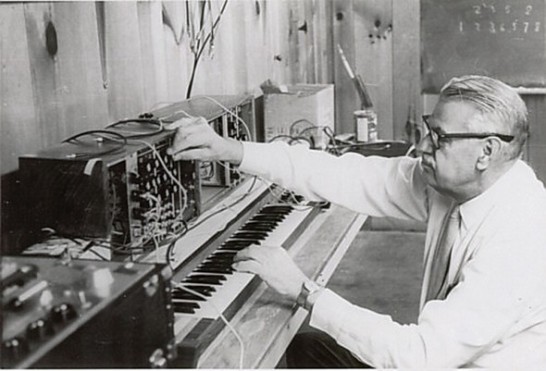
Bob Moog Foundation Archives Historian Brian Kehew has published an interesting look at the 1965 R.A. Moog Co. Electronic Music Workshop.
On August 9, 1965, a small summer conference was held to teach electronic music and expose the new Moog synthesizer to the world of composers. For three weeks, 12 participants got an in-depth look at electronic music and hands-on experiences with a state-of-the-art electronic music studio:
Each “studio” featured a Moog synthesizer with very few modules (by later standards).
As seen in the photo, J.D.Robb works on this early Moog system in the front of the “classroom”. It has only 2 oscillators, 2 VCAs, ADSR, and two controllers: a keyboard and a “slide wire” controller (like a ribbon but using a wire contact to slide across a resistive material, seen just above the keyboard.) The modules shown in the photo are early versions, and one is even a handmade panel to connect and choose between the two controllers.
Each of the synthesizers had a unique module or two: One had a voltage-controlled low-pass filter, one had a band-pass filter, two had white-noise generators, and one studio had spring reverb available. It seems odd that the very factory that made the synthesizer modules would not have more to “go around”, but recall that most of their work went into making amplifiers, and making quantities of spare synthesizer modules was difficult for the minimally-profitable small company
It is noteworthy that the one main studio was kept assembled after the seminar, and became the first “Moog factory studio”; the legendary test bed for many subsequent products and artists. An in-house studio provided a “demo room” for visiting musicians and a professional workspace to compose and record music.
See Kehew’s article for more details, reflections of attendees and photos from the workshop.

Gosh, I wish I'd been there. I recall that the summer of 1965 went on for ever, as I approached my 6th birthday. I wasn't even into electronics then, hadn't built my first crystal set. On reflection, I probably wouldn't have got much out of the seminars. But wow, what a seminal event.
(On reflection, it was only three years later that I was playing with a tape recorder while shouting into the family upright piano to make weird sounds.)
The description of the modular synthesizer above sounds a bit like the state of play of my homebrew modular that I've been building since January. I expect it to be much bigger in a couple of years, although it's largely built from surplus parts gathered over the previous decade. Ah, so many projects, so few lifetimes…
That must have been pretty mindblowing back then!
I'd be happy with a modular that size today though….
Must have been quite the "garage" or "studio" project for Bob.
Analog "subtractive" synthesis technique, was quite the advancement for the time (and even now).
Patch cord were simple, yet effective — showing a clear connection to the electronics and modules.
Tuning this must have been interesting with temperature variations!
"Tuning this must have been interesting with temperature variations!"
In the full document (referenced above), there is a reference to this problem, including an ironic comment about working in "10-note equal temperament" It's a good read, but almost everywhere I go on that site, my computer warns me about malware, so I'm cautious…
It's a good read, but almost everywhere I go on that site, my computer warns me about malware, so I'm cautious…